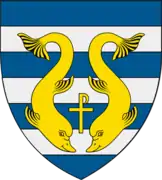Baia, Tulcea
Baia is a commune in Tulcea County, Northern Dobruja, Romania.
Baia | |
|---|---|
 Location in Tulcea County | |
 Baia Location in Romania | |
| Coordinates: 44°43′N 28°40′E | |
| Country | |
| County | Tulcea |
| Subdivisions | Baia, Camena, Caugagia, Ceamurlia de Sus, Panduru |
| Government | |
| • Mayor | Nicolae Ionuş (since 2004) |
| Area | 198.29 km2 (76.56 sq mi) |
| Population (2011)[1] | 4,758 |
| • Density | 24/km2 (62/sq mi) |
| Time zone | EET/EEST (UTC+2/+3) |
| Postal code | 827005 |
| Vehicle reg. | TL |
| Website | www |
Villages
The commune includes five villages:
History
In 1953, archaeological excavations on a site along the Lake Golovița, near Baia, led to the discovery of a new Middle Neolithic culture, named after the commune. Further research has shown that the culture, with Mediterranean origins, extended across Dobruja and North-Eastern Bulgaria. The culture's most notable artefact is an anthropomorphic statuette in terra cotta, known as The Thinker, which was discovered at Cernavodă.
References
- "Populaţia stabilă pe judeţe, municipii, oraşe şi localităti componenete la RPL_2011" (in Romanian). National Institute of Statistics. Retrieved 4 February 2014.
This article is issued from Wikipedia. The text is licensed under Creative Commons - Attribution - Sharealike. Additional terms may apply for the media files.
